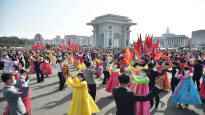North Korea’s missile tests have developed alarmingly and intimidation towards neighboring countries has increased, the researcher estimates. The war of words that intensified on the Korean peninsula in the early part of the year is linked to the change of president of South Korea.
North Korea has begun conducting missile tests at a tremendous rate.
This year, it has done tests with an average of one per week. During the first part of the year, it has already fired 13 missile tests, compared to seven throughout the past year.
What is worrying for neighboring countries is that the tests have almost invariably been successful and have taken North Korea’s armaments project forward, says a nuclear program expert Olli Heinonen an incubator from the Stimson Center in Washington.
Heinonen monitors North Korea’s nuclear program as an expert in the Korea 38 program at the Stimson Center.
Meanwhile, the political climate on the Korean peninsula has intensified as South Korea elected a conservative party as its president in the March election. Yoon Suk-yeolin.
In his election campaign, he criticized the current presidentMoon Jae-in too soft an attitude towards a neighboring country. Yoon will take office in mid-May.
An ambitious missile program in North Korea
North Korea’s missile projects are huge.
It is simultaneously developing several types of missiles: cruise missiles, ballistic missiles launched from land and submarines, and, as a new target, a hypersonic missile capable of flying at multiple speeds of sound.
At the same time, North Korea is experimenting with solid fuel, which will improve missile mobility and shorten launch preparation time, explains Olli Heinonen, a nuclear program expert.
Two months ago, North Korea managed to detonate a missile in the air before it hit the ground. Heinonen considers this to be a worryingly good result.
– This is an important step in the launch of a nuclear weapon. A nuclear weapon is not detonated when it hits the ground, but is detonated above the ground for maximum destructive power.
The intercontinental missile test was successful after a five-year hiatus
North Korea says it has launched a new-generation Hwasong-17 missile, but this has not yet been confirmed by Western experts.
– It was a successful experiment. The missile flew very high, about 6,200 kilometers and came down intact, says Olli Heinonen.
He notes that the missile’s trajectory was almost vertical up and then the drop down was abnormal, but in accordance with the laws of physics.
– When a missile is made to rise high, it is also made to fly farther.
Therefore, the authorities in the United States are closely following the details of the tests.
– Experts are concerned about whether the missile was Hwasong-15, which has been tested and developed by North Korea for a long time.
The best runway on Hwasong 15 is 13,000 kilometers. It extends far beyond the west coast of the United States, depending on the trajectory and the amount of gun cargo, Heinonen reminds.
A failed missile test was thrown into a suburb of Pyongyang
However, the trials have also become a backseat, of which North Korea does not tell the public.
This was the week before the successful testing of the ballistic missile at the end of March, says Olli Heinonen.
– The missile test on March 16 apparently failed immediately after departure and parts of the missile fell in the suburbs of the capital Pyongyang.
North Korea has not publicly stated that it even conducted the test at the time. Experts say a new-generation Hwasong-17 missile was destroyed in that test. It has a range of 15,000 kilometers.
– The answer to this is likely to be found if Japan or its allies manage to lift pieces of the missile out of the sea, says Heinonen.
The United States anticipates that North Korea will soon test its nuclear weapons
Special Representative of the United States Department of State for North Korea Sung Kim estimates last week that a possible date would be April 15, which is the founder of the North Korean state Kim Il-sungin 110th birthday.
Nuclear program expert Olli Heinonen does not believe in this assessment.
– Based on recent satellite images, it is difficult to believe that a nuclear test will be carried out in North Korea in the near future. Tunnels have been excavated slightly in the Punggye test area, but no equipment is visible.
According to Heinonen, the much-publicized US speeches are mainly a warning to North Korea. Washington wants to show that it is following North Korea’s nuclear program, and if a nuclear weapon is tested, the United States will respond.
North Korea has been disappointed with the United States and the new president of E-Korea
The political climate on the Korean Peninsula began to intensify in the early part of the year, partly due to South Korea’s presidential election campaign. Both the current administration and the Conservative line, which won the election, sought support through tough speeches.
With North Korea, he doesn’t just want to negotiate like current President Moon Jae-in. Yoon has said he is calling on North Korea to take reciprocal steps to improve relations.
The starting point for foreign policy is North Korea’s renunciation of nuclear weapons. The most sensitive issue is the prominent rise to human rights in North Korea.
Nuclear program expert Olli Heinonen also says that North Korea is disappointed with the president Joe Biden an administration that does not attract that negotiating table by offering various benefits.
– North Korea is not ready to discuss any issues, Heinonen says.
You can discuss the subject until Thursday at 11 p.m.
